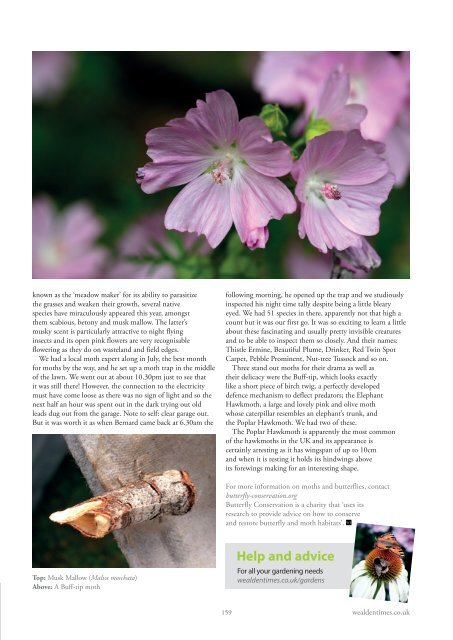Wealden Times | WT212 | October 2019 | Kitchen & Bathroom supplement inside
Wealden Times - The lifestyle magazine for the Weald
Wealden Times - The lifestyle magazine for the Weald
You also want an ePaper? Increase the reach of your titles
YUMPU automatically turns print PDFs into web optimized ePapers that Google loves.
known as the ‘meadow maker’ for its ability to parasitize<br />
the grasses and weaken their growth, several native<br />
species have miraculously appeared this year, amongst<br />
them scabious, betony and musk mallow. The latter’s<br />
musky scent is particularly attractive to night flying<br />
insects and its open pink flowers are very recognisable<br />
flowering as they do on wasteland and field edges.<br />
We had a local moth expert along in July, the best month<br />
for moths by the way, and he set up a moth trap in the middle<br />
of the lawn. We went out at about 10.30pm just to see that<br />
it was still there! However, the connection to the electricity<br />
must have come loose as there was no sign of light and so the<br />
next half an hour was spent out in the dark trying out old<br />
leads dug out from the garage. Note to self: clear garage out.<br />
But it was worth it as when Bernard came back at 6.30am the<br />
following morning, he opened up the trap and we studiously<br />
inspected his night time tally despite being a little bleary<br />
eyed. We had 51 species in there, apparently not that high a<br />
count but it was our first go. It was so exciting to learn a little<br />
about these fascinating and usually pretty invisible creatures<br />
and to be able to inspect them so closely. And their names:<br />
Thistle Ermine, Beautiful Plume, Drinker, Red Twin Spot<br />
Carpet, Pebble Prominent, Nut-tree Tussock and so on.<br />
Three stand out moths for their drama as well as<br />
their delicacy were the Buff-tip, which looks exactly<br />
like a short piece of birch twig, a perfectly developed<br />
defence mechanism to deflect predators; the Elephant<br />
Hawkmoth, a large and lovely pink and olive moth<br />
whose caterpillar resembles an elephant’s trunk, and<br />
the Poplar Hawkmoth. We had two of these.<br />
The Poplar Hawkmoth is apparently the most common<br />
of the hawkmoths in the UK and its appearance is<br />
certainly arresting as it has wingspan of up to 10cm<br />
and when it is resting it holds its hindwings above<br />
its forewings making for an interesting shape.<br />
For more information on moths and butterflies, contact<br />
butterfly-conservation.org<br />
Butterfly Conservation is a charity that ‘uses its<br />
research to provide advice on how to conserve<br />
and restore butterfly and moth habitats’.<br />
Top: Musk Mallow (Malva moschata)<br />
Above: A Buff-tip moth<br />
Help and advice<br />
For all your gardening needs<br />
wealdentimes.co.uk/gardens<br />
159 wealdentimes.co.uk


















